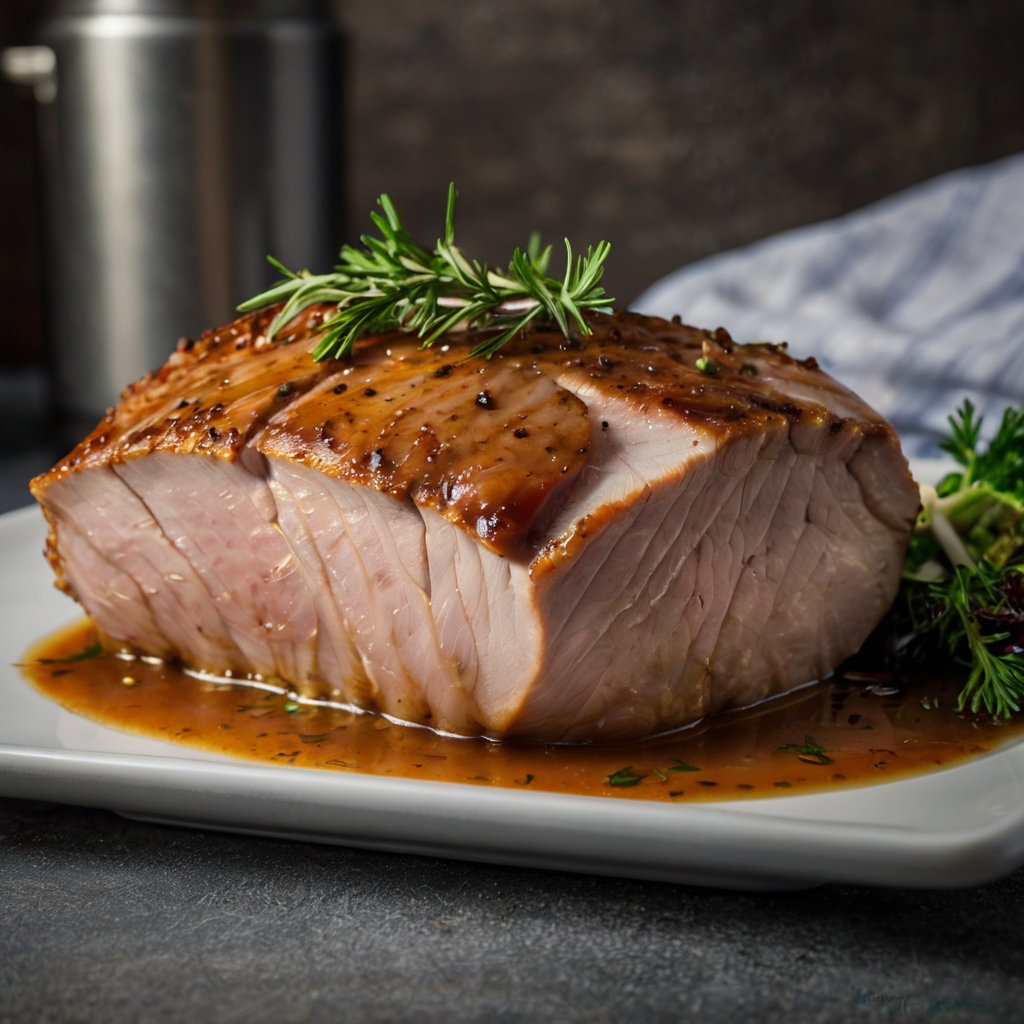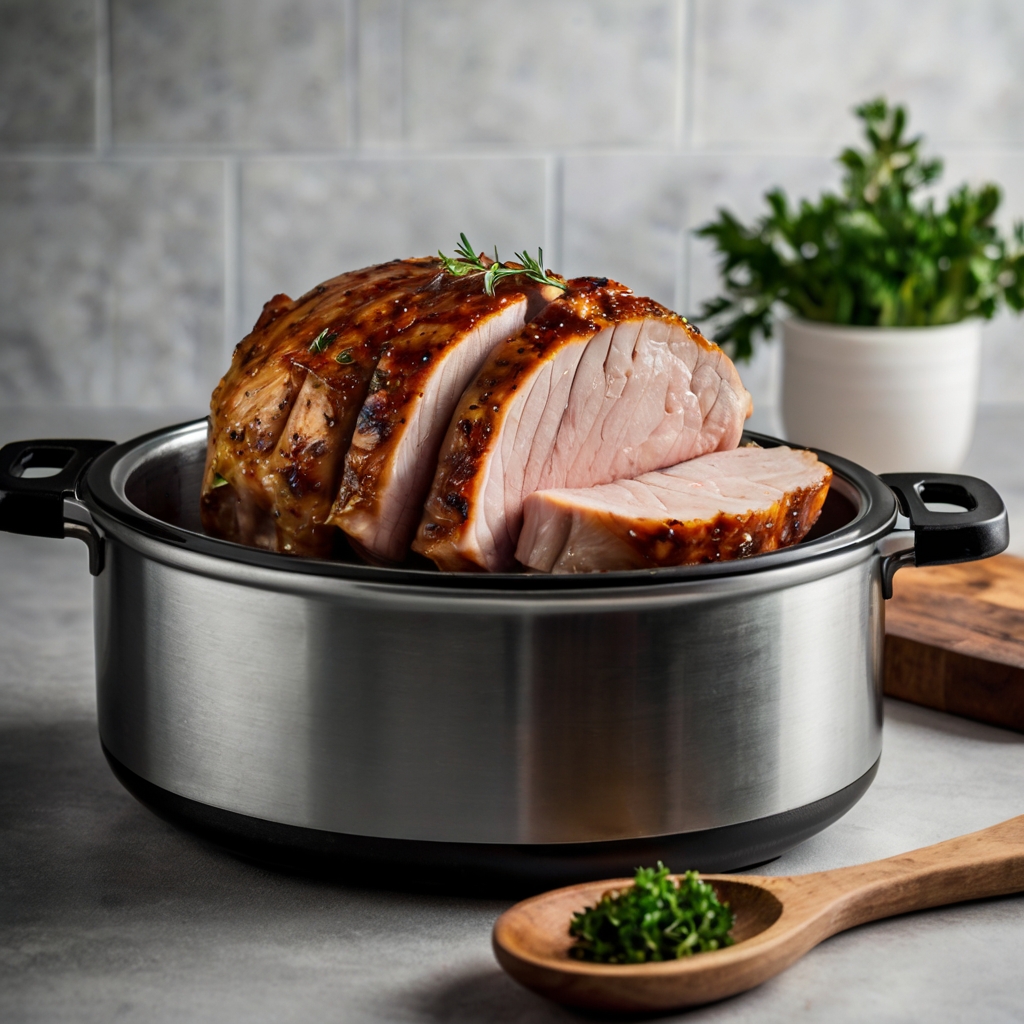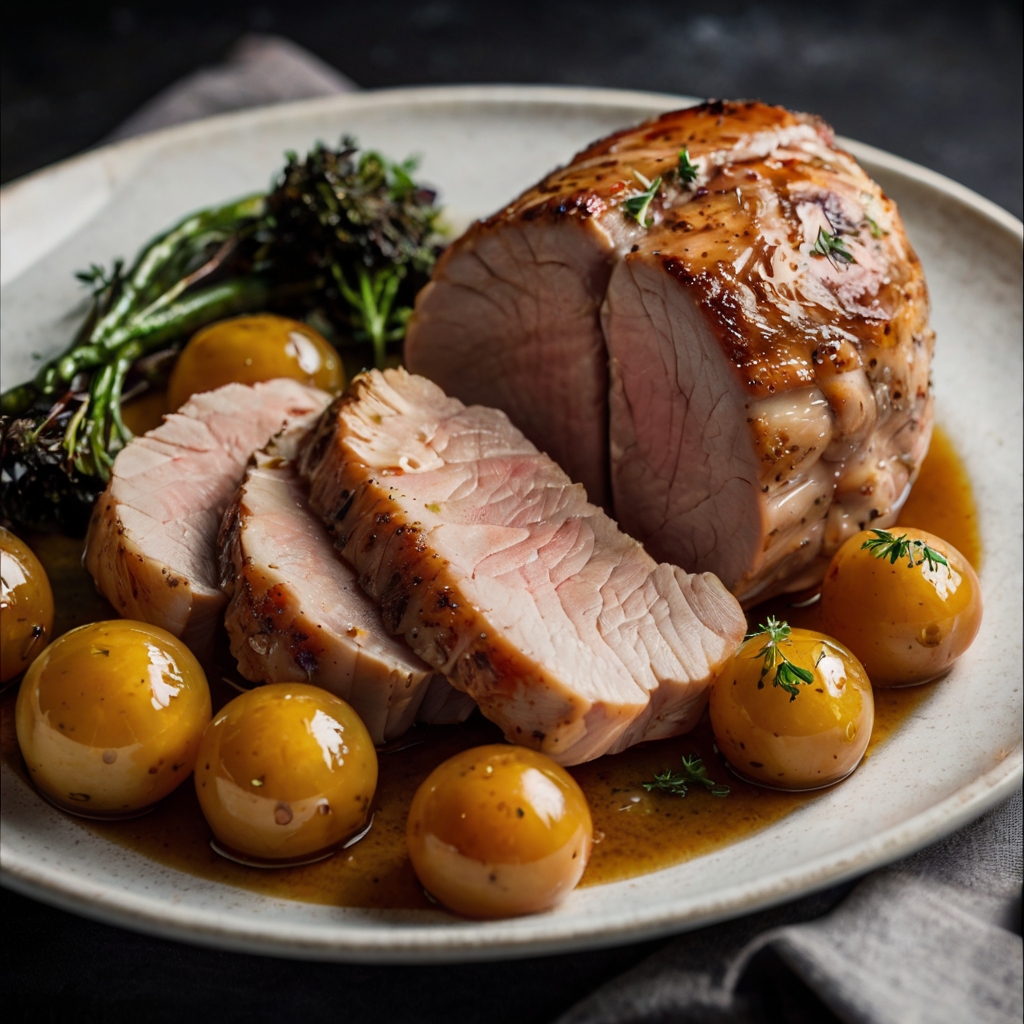Pork Loin in a Pressure Cooker: How to Make Meat Juicy

Hi, my name is Chef Marcus. Over the last 20 years in professional kitchens, I’ve learned one golden truth: mastering the basics can make you feel like a kitchen wizard. Today, I’m going to walk you through one of my favorite time-saving and flavor-packed tricks — making juicy, tender pork loin in a pressure cooker. Whether you’re cooking for your family on a Tuesday or meal-prepping for the week, this is a skill you’ll want in your culinary toolkit.
Cooking Pork Loin in a Pressure Cooker
Why Use a Pressure Cooker for Pork Loin?

Let’s start with the obvious: pork loin is a lean cut. That means it’s easy to dry out — especially if you’re not watching the clock. Enter the pressure cooker. This powerhouse traps moisture and flavor, transforming your pork into something truly restaurant-worthy — in a fraction of the time.
No more hovering over the oven or pan. Just set it, seal it, and let the magic happen.
Pro Tip: In a pressure cooker, pork loin cooks in 20–30 minutes — versus up to 90 minutes in a traditional oven.
What Cut of Pork Works Best? (Loin vs. Tenderloin vs. Shoulder)
Not all pork cuts are created equal. Here’s a quick breakdown to help you pick the right one:
| Cut | Texture | Best For | Cooking Time (Pressure Cooker) |
| Pork Loin | Lean, firm | Roasts, sliced medallions | 20–25 min per 2 lbs |
| Pork Tenderloin | Extra lean, delicate | Quick-cook dishes | 3–5 min per piece (whole) |
| Pork Shoulder | Fatty, shreddable | Pulled pork, stews | 60–90 min per 3–4 lbs |
I recommend pork loin if you want something elegant, sliceable, and fast. Save the shoulder for low-carb pulled pork sandwiches.
Ideal Time and Temperature for Juicy Results
Cooking times can vary based on size, but here’s a solid starting point:
- Pressure Level: High
- Time: 20–25 minutes for a 2–2.5 lb pork loin
- Rest Time: Let it naturally release for 10 minutes, then slice
Use a meat thermometer to check doneness. The USDA recommends 145°F (63°C) — I pull it at 140°F and let it rest to finish cooking.
Prepping the Pork Loin
Trimming and Seasoning Tips
Start by trimming off excess fat and silver skin (that tough membrane on the side). Leave a thin layer of fat for flavor, but remove anything that looks chewy or sinewy.
For seasoning, you can go classic or bold. My go-to mix?
Chef Marcus’ Dry Rub Blend
- 1 tbsp kosher salt
- 1 tsp smoked paprika
- 1 tsp garlic powder
- ½ tsp onion powder
- ½ tsp dried thyme
- Fresh cracked pepper to taste
Massage the rub generously into the meat and let it sit while you prep the rest.
Marinating or Dry Rub: What’s Better?
This depends on how much time you have:
| Method | Flavor Depth | Time Needed | Texture Result |
| Marinate | Deep, complex | 4–12 hours | Moist, slightly tenderized |
| Dry Rub | Bold, punchy | 15–30 min | Crusty, well-seasoned |
I love a dry rub when I’m short on time — it creates a nice bark when you sear it.
Searing the Pork Before Pressure Cooking
Is It Necessary? What It Adds to Flavor
Technically, no — but as a chef, I always say sear for the soul. That golden crust adds layers of umami and locks in juices. Plus, all those brown bits (called fond) in the pot? They make your sauce taste like heaven.
Here’s how I do it:
- Turn the pressure cooker to Sauté mode
- Add 1 tbsp olive oil
- Sear all sides of the pork for 2–3 minutes each
- Deglaze with a splash of broth or wine to lift the flavor into your liquid
Pressure Cooking Pork Loin Step-by-Step
Basic Pork Loin Recipe for the Pressure Cooker
This is the foundation recipe I teach my students — simple, reliable, and full of rich flavor.
Ingredients:
- 2–2.5 lb pork loin
- 1 tbsp olive oil
- 1 cup chicken broth (or alternative liquid)
- 1 tsp salt
- ½ tsp pepper
- Optional: onion quarters, garlic cloves, fresh rosemary
Instructions:
- Sear pork loin on all sides (use “Sauté” mode).
- Deglaze with a splash of broth to lift browned bits.
- Place loin on a trivet (optional, but helps with even cooking).
- Add remaining broth and aromatics.
- Lock lid, set to High Pressure, and cook for 20–25 min.
- Natural release for 10 minutes, then open lid.
- Rest, slice, and serve with juices or sauce.
Chef’s Note: Add a splash of white wine or balsamic vinegar for acidity — it brightens the flavor beautifully.
Liquid Choices: Broth, Water, or Wine?
You always need at least 1 cup of liquid in a pressure cooker to build steam — but which one? Here’s a breakdown:
| Liquid | Flavor Profile | Best For |
| Chicken Broth | Savory, rich | Classic pork loin dishes |
| Water | Neutral | When seasoning is already bold |
| White Wine | Bright, slightly acidic | Herb or garlic marinades |
| Apple Cider | Sweet, aromatic | Fall flavors, apple sauces |
| Soy Sauce (diluted) | Umami, salty | Asian-style pork loins |
I personally love broth with a splash of wine — gives you depth and brightness.
Natural vs. Quick Release: Which Is Better?
Here’s the deal — pork loin isn’t brisket, but it still needs time to relax. Natural release helps keep the juices inside.
| Release Type | How It Works | Best For |
| Natural Release | Wait 10–15 min, no venting | Juicy pork, delicate meats |
| Quick Release | Manual venting, fast steam | Veggies, time crunch |
I always go for Natural Release — it’s the secret to avoiding dry meat.
Cooking Frozen Pork Loin: Is It Safe?
Yes — you can pressure cook pork loin from frozen! Just skip the sear (obviously), and add 8–10 extra minutes to the cook time.
Frozen Pork Loin Cooking Cheat Sheet:
| Weight | Cook Time (High Pressure) |
| 2 lbs | 28–30 minutes |
| 2.5 lbs | 32–35 minutes |
Pro tip: Rub seasoning on the meat before freezing — that way, it’s already marinated when you toss it in the pot.
Flavor Variations and Sauces
Let’s talk upgrades. These are four of my signature variations — easy enough for beginners, but flavorful enough for any dinner guest.
Garlic Herb Pork Loin with Gravy
- Seasoning: rosemary, thyme, garlic powder, olive oil
- Liquid: chicken broth + splash of white wine
- Sauce: remove pork, reduce liquid, whisk in a cornstarch slurry
This is my go-to when I want something rustic and comforting. Pairs great with mashed cauliflower or green beans.
BBQ-Style Pork Loin with Homemade Sauce
- Seasoning: paprika, brown sugar, cumin, chili powder
- Liquid: ½ cup broth + ½ cup homemade or store BBQ sauce
- Sauce: thicken cooking liquid or brush on more BBQ after slicing

I use this for sliders and meal-prep bowls. Add slaw and toasted buns — chef’s kiss.
Asian-Inspired Pork Loin with Soy-Ginger Glaze
- Seasoning: soy sauce, ginger, garlic, sesame oil
- Liquid: ¾ cup broth + 2 tbsp soy + 1 tbsp rice vinegar
- Sauce: reduce and drizzle with a little honey or hoisin
Slice it thin and serve with jasmine rice and steamed bok choy. Weeknight perfection.
Apple Cider Pork Loin with Fall Spices
- Seasoning: cinnamon, nutmeg, garlic, salt
- Liquid: 1 cup apple cider
- Sauce: reduce and stir in a spoonful of Dijon mustard
This one’s a crowd favorite at Thanksgiving. Try serving it over roasted sweet potatoes.
Sides and Serving Suggestions
Best Low-Carb Sides to Pair with Pork Loin
When I serve pork loin, I always look for sides that let the main dish shine without stealing the spotlight—or spiking the carbs. These are some of my go-to low-carb pairings from years of testing in both home and professional kitchens:
| Side Dish | Flavor Profile | Why It Works |
| Roasted Brussels Sprouts | Earthy, slightly sweet | Complements pork’s richness |
| Cauliflower Mash | Creamy, mild | Classic comfort-food replacement |
| Garlic Green Beans | Crisp, aromatic | Adds crunch and freshness |
| Zucchini Noodles | Light, absorbent | Great with sauces or glazes |
| Broccoli with Lemon | Bright, slightly bitter | Cuts through fatty cuts beautifully |
These sides are not only low in carbs—they’re fast and easy to prep while the pork is cooking.
Making Mashed Cauliflower or Veggies in the Same Pot
Want to streamline dinner? Here’s how I make mashed cauliflower without needing a second pan:
Steps:
- After pressure cooking your pork loin, remove it and set it aside to rest.
- Add cauliflower florets directly into the pot with the remaining liquid.
- Pressure cook on high for 2–3 minutes, quick release.
- Drain excess liquid, return cauliflower to pot.
- Add butter, salt, garlic, and mash until smooth.
You can also add a splash of cream cheese or Parmesan to make it even silkier.
Pro tip: If using a trivet under your pork loin, just place cauliflower in the broth underneath while the pork cooks.
How to Use Leftovers (Tacos, Bowls, Sandwiches)
Pork loin is one of the most versatile proteins for leftovers. Here are a few of my favorite transformations:
| Leftover Idea | Prep Tips |
| Low-Carb Tacos | Shred pork, add cabbage slaw + avocado |
| Power Bowls | Layer pork with cauliflower rice, veggies |
| Lettuce Wraps | Add sliced pork, hoisin or mustard |
| Keto Grilled Cheese | Use low-carb bread, melted cheddar |
| Pork Fried “Rice” | Toss with riced cauliflower + egg + soy |
I always say: cook once, eat twice—or even three times, if you’re clever about it.
Common Mistakes and Troubleshooting
Pork Loin Came Out Dry—What Went Wrong?
Dry pork loin usually comes down to overcooking or lack of fat. Here’s what to check:
- Cook Time: Stick to 20–25 minutes for a 2–2.5 lb loin.
- Natural Release: Skip quick release to lock in juices.
- Searing: Don’t skip it—browning builds flavor and crust.
- Rest Time: Always let it rest 5–10 minutes before slicing.
Also, consider using a slightly fattier cut like pork shoulder if juiciness is your top priority.
Sauce Too Thin? Here’s How to Fix It
Thin sauces are common after pressure cooking. Why? There’s no evaporation inside the pot. Here’s how I fix that:
- Simmer: Use “Sauté” mode and let the sauce reduce for 5–10 minutes.
- Slurry: Mix 1 tablespoon of cornstarch with cold water and whisk it in.
- Butter Finish: For creamier texture, finish with a tablespoon of cold butter off-heat.
I also like to blend in roasted garlic or mustard for flavor depth when thickening sauces.
Meat Didn’t Cook Through: What to Do Now

If your pork loin looks underdone after pressure cooking, don’t panic. Here’s what to do:
- Check the internal temperature with a meat thermometer—it should read 145°F (63°C).
- If it’s lower, seal the lid again and cook for 5–8 more minutes on high pressure.
- Let it natural release for 5 minutes.
This often happens with thicker cuts or when starting from frozen. Always check your meat size and adjust accordingly.
15+ FAQ Cooking Pork Loin in a Pressure Cooker
1. Can I use pork tenderloin instead of pork loin?
Yes, but reduce cook time to 4–6 minutes. Tenderloin is leaner and smaller.
2. Do I need to add oil or fat when pressure cooking pork loin?
Only for searing. During pressure cooking, the steam does all the work.
3. What’s the best seasoning for pork loin?
Garlic, rosemary, paprika, salt, pepper—keep it simple and flavorful.
4. Can I pressure cook pork loin without searing?
Yes, but searing adds texture and flavor. I recommend it when you have the time.
5. How do I store leftover pork loin?
Slice it, let it cool, and store in an airtight container for up to 4 days.
6. Can I freeze cooked pork loin?
Absolutely. Wrap tightly and freeze for up to 2 months. Thaw overnight in the fridge.
7. Why is my pork tough even though I followed the time?
Likely overcooked or sliced too soon. Let it rest and slice thinly against the grain.
8. Can I add veggies in with the pork loin?
Yes, but add them later or cut thick—veggies cook faster than meat.
9. What’s the best release method for pork?
Natural release is best to keep juices inside.
10. Can I make pork loin in a stovetop pressure cooker?
Yes, but adjust cook time slightly depending on your pressure level.
11. Is it safe to cook frozen pork without thawing?
Yes, pressure cooking handles frozen meat well. Just extend cook time.
12. How can I add more flavor to the pork loin?
Use broth or wine, fresh herbs, and always salt your meat well before cooking.
13. Can I use a spice rub instead of marinade?
Definitely. Dry rubs are fast and flavorful.
14. Should I cut the pork loin in half to fit the pot?
Yes, if needed. It won’t affect cooking as long as time is correct.
15. Can I make gravy from the juices?
Yes, reduce the liquid, add a slurry or butter, and season to taste.